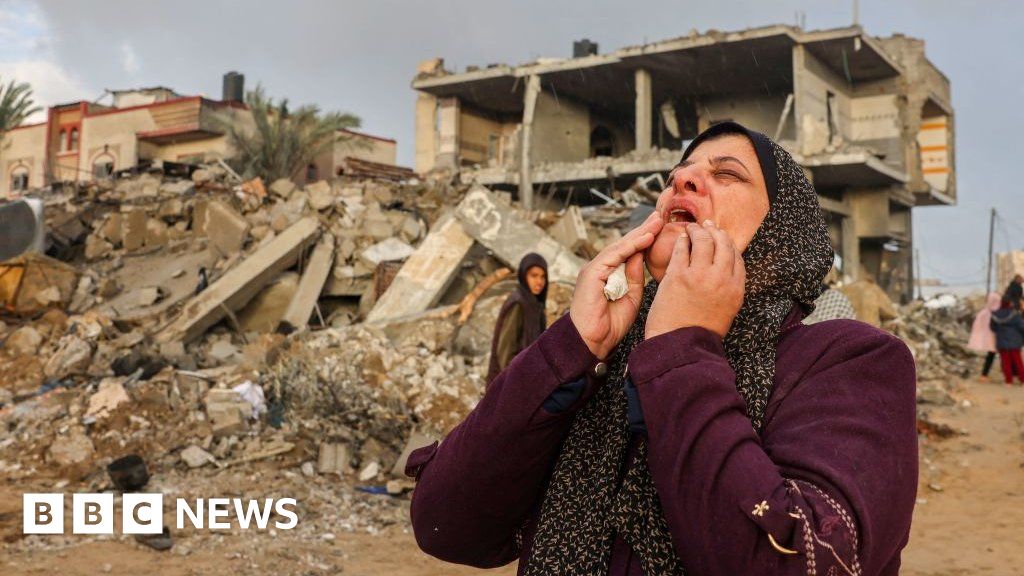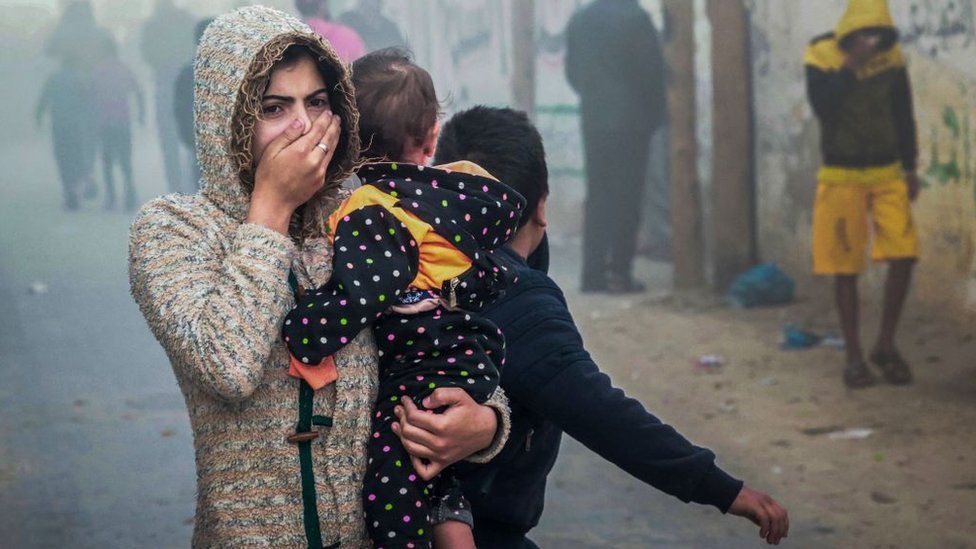

Hamas gunmen launched an unprecedented assault on Israel from the Gaza Strip on 7 October, killing 1,200 people and taking about 240 hostages.
The Israeli military responded with air strikes on Gaza, and launched a ground offensive. More than 15,800 people have been killed in Gaza, according to the Hamas-run government.
Fighting has resumed following the end of a seven-day truce, during which Hamas released more than 100 hostages in exchange for 240 Palestinians.
What is the goal of Israel’s military operation in Gaza?
Israel Defense Forces (IDF) warplanes have been carrying out strikes across Gaza while its troops moved through the north of the territory.
Prime Minister Benjamin Netanyahu said Israel has a “clear goal of destroying Hamas’s military and governing capabilities”, as well as freeing the hostages.
He also declared that Israel would have “overall security responsibility” for the Gaza Strip “for an indefinite period” after the conflict. Israel later said it has no plans to reoccupy the territory.
Israel has drafted 300,000 reservists for the operation, to boost its standing force of 160,000.
What is happening on the ground in Gaza?
The IDF says it has struck thousands of targets belonging to Hamas – which Israel, the UK, US and other Western powers class as a terrorist organisation.
It also says it has destroyed hundreds of tunnel shafts built underneath Gaza. Hamas has claimed that its tunnel network stretches for 500km (310 miles).
A number of hospitals in the north were caught up in intense fighting, along with the Jabalia refugee camp.
Since the temporary ceasefire ended, Israeli troops have pushed into southern Gaza, and have taken “aggressive” action against Hamas and other armed groups around the city of Khan Younis.
Israel claims to have killed thousands of Hamas fighters during the war, including many commanders. More than 390 Israeli soldiers have been killed, most of them in the 7 October attack.
The IDF says 75 Israeli troops have been killed in Gaza since the conflict began.
Who are the hostages and how many have been freed?
During the 7 October attacks, Hamas took about 240 hostages, which it said were hidden in “safe places and tunnels” within Gaza.
Israel said more than 30 of the hostages were children, and that at least 10 were aged over 60. It also said about half of the hostages had foreign passports from 25 different countries.
Under a deal brokered by Qatar, a pause in the fighting began on Friday 24 November.
Large crowds have been gathering in the occupied West Bank to greet Palestinians released from Israeli jails
During the seven-day truce, 105 hostages were freed, in return for 240 Palestinians who had been held in Israeli jails and detention.
- 78 Israeli women and children
- 23 Thai hostages and one Filipino
- 3 Russian-Israelis
Hamas released four Israeli hostages before the truce agreement was made, and another hostage was freed by Israeli forces.
Hamas has said other armed groups in Gaza are holding hostages, including Palestinian Islamic Jihad, which could complicate any future releases.
What is the humanitarian situation in Gaza?
The UN has warned that “an even more hellish scenario is about to unfold” in the Gaza Strip, and that its humanitarian operations may not be able to respond.
More than 36,000 people have been wounded in Gaza since the start of the war, according to the Hamas-run government. It says three quarters of them are children and women.
Few of Gaza’s hospitals are still operational due to damage caused by attacks and the lack of electricity and fuel.
Mr Netanyahu has admitted that Israel has been “not successful” in minimising civilian casualties, but insisted this is because Hamas uses Gaza’s population as human shields.
Some schools in the south have been turned into makeshift medical facilities
This includes the hundreds of thousands of people who fled the fighting in the north after an Israeli ultimatum to move south of a river known as Wadi Gaza for their own safety.
Israel’s military subsequently published a map with Gaza split into grids, showing areas where people should go to for safety.
But the BBC’s international editor Jeremy Bowen said the map is complicated, includes conflicting information, and requires a smartphone for access.
The city has been hosting hundreds of thousands of residents who moved to escape the fighting in the north. Many displaced people are sheltering in places such as the city’s hospitals.
How much humanitarian aid has entered Gaza?
After the 7 October attack, Israel shut its border crossings with Gaza, preventing the usual supplies of food, water, fuel and medicine from entering the territory.
Israel obstructed all fuel deliveries until late November, arguing it could be stolen by Hamas and used for military purposes.
Without electricity or fuel for generators, hospitals, water pumps and desalination plants, waste and sanitation services, and bakeries have been unable to function.
Israel allowed 1,399 lorry loads of humanitarian supplies to enter via Egypt’s Rafah border crossing between 21 October and 21 November, compared with a monthly average of 10,000 before the war, according to the UN.
During the truce, hundreds of lorries carrying aid and fuel were allowed to enter Gaza through the Rafah crossing – the only functioning passage in and out of Gaza. But it has been very difficult to get goods into the north.
Hundreds of foreign passport holders – including some British and US citizens – and seriously wounded and sick Palestinians have also been allowed to leave, but many remain. The Rafah crossing remains tightly controlled by Egypt.
What happened during the Hamas 7 October attack on Israel?
On 7 October, hundreds of Hamas gunmen crossed from the Gaza Strip into southern Israel, breaking through the heavily guarded perimeter fence, landing by sea, and using paragliders.
The gunmen killed about 1,200 people, most of them civilians, in a series of raids on military posts, kibbutzim and a music festival, and took hostages back into Gaza.
Earlier estimates put the death toll at more than 1,400.
A young women kneels at a vigil for the hostages in the Israeli city of Tel Aviv
The attack came at a time of soaring Israeli-Palestinian tensions: 2023 has been the deadliest on record for Palestinians who live in the Israeli-occupied West Bank.
What is Hamas and what does it want?
Hamas is a Palestinian group which has run Gaza since 2007.
The name is an acronym for Harakat al-Muqawama al-Islamiya, which means Islamic Resistance Movement.
The group wants to destroy Israel and replace it with an Islamic state.
Yahya Sinwar, leader of Hamas’s political wing in Gaza, pictured in 2021
Its military wing, the Izzedine al-Qassam Brigades, is thought to have about 30,000 members.
Hamas has fought several wars with Israel since it took power, firing thousands of rockets into Israel and carrying out other deadly attacks.
In response, Israel has repeatedly attacked Hamas with air strikes, sending in troops in 2008 and 2014.
Hamas – or in some cases the al-Qassam Brigades – has been designated a terrorist group by Israel, the US, the EU and the UK, as well as other powers.
Iran backs the group, providing funding, weapons and training.
Where is the Gaza Strip and how big is it?
The Gaza Strip is a 41km (25-mile) long and 10km-wide territory located between Israel, Egypt and the Mediterranean Sea.
Israel withdrew its troops and around 7,000 settlers from the territory in 2005.
Home to2.2 million people, the narrow strip is one of the most densely-populated areas in the world.
Just over three-quarters of Gaza’s population – some 1.7 million people – are registered refugees or descendants of refugees, according to the UN.
Before the latest conflict, more than 500,000 people lived in eight refugee camps located across the Strip.
Israel controls the air space over Gaza and its shoreline, and strictly limits the movement of people and goods.
What is Palestine?
The West Bank and Gaza are known as the Palestinian territories. Along with East Jerusalem and Israel, they formed part of a land known as Palestine from Roman times until the mid-20th Century.
In 1948, part of Palestine became Israel, which was recognised by the United Nations the following year. The West Bank (including East Jerusalem) and Gaza are recognised as Palestine by many countries and bodies, although it does not have member status at the UN.
Those who do not recognise Israel’s right to exist also still refer to all of the land as Palestine.
He has been the leader of the Palestinian Authority (PA) since 2005, and represents the Fatah political party – a bitter rival of Hamas.
